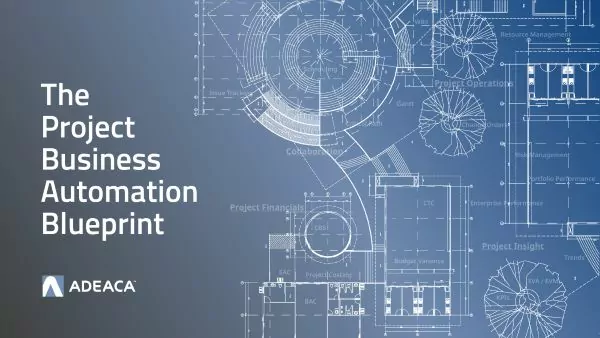While most project management applications have the capabilities to create, save and use project templates, Project Models take it to a whole new level. By taking the specifications of a project template and making them variable inputs that any user can update easily, Project Models increase the speed and accuracy of creating projects immensely. In fact, after the model generates the new project there are very few, if any changes required.
This is the fifth blog in the Project Modeling series (see the fourth here). This blog will discuss how to design project models with Project Business Automation.
Designing Project Models with Project Business Automation from Adeaca
As mentioned in a previous blog, Project Modeling as part of your Project Business Automation system ensures accuracy and speed in the project initiation phase. When you are off on the right foot, it is an easier transition to execution and completion.
Download the Project Modeling Whitepaper to learn how to create a streamlined and controlled planning and estimating process for your company.
A Project Model in Adeaca PBA is designed by starting with a project template. The process of designing the model takes that template and makes it a dynamic entity used in building projects. Instead of inserting the template as is, the modeler allows the user to manipulate the template before insertion, so it enters completely configured per the new project’s specifications.
Normally, you might create many different project templates that try to fit different project scenarios. However, with Project Modeling, you can use one template that can be configured in an unlimited number of ways which makes the process much more streamlined and precise. This also saves a tremendous amount of time.
The project template gives the Project Modeler the baseline work breakdown structure (WBS) and cost breakdown structure (CBS) it will use.
To build a Project Model in Adeaca PBA, you need three key components:
- Variables: Variables are the primary components you want the user to be able to configure during Project Modeling. They are called Variables because they are the parts of the template that can vary based on your specific project.
For example, a commercial HVAC contractor offers various types of sizes of HVAC systems. A primary variable for this contractor might be the size of the system (i.e. capacity). A Variable type can be specified as Numeric or Selection. That means the user will specify either a quantity of this Variable or will choose from a list of options for this Variable.
- Selections: Selections are the options available to Variables that are specified as Selection. An unlimited number of options can be created as Selections. Based on the HVAC contractor example above, a user will have a Variable of “System Capacity.” A number of options will be presented to the user (e.g. 5000 CFM or 10,000 CFM). The user will then select which size this project requires.
- Formulas: Formulas can generate sophisticated calculations for the WBS and CBS output. The quantities specified on the Variables and Selections can be used in the Formulas section. For example, if you know that every 5000 CFM HVAC unit requires 10 hours of labor to install, that can be calculated without requiring the user to enter it manually. This saves a lot of time. The user may specify eight 5000 CFM units and the system will calculate the 80 hours of installation labor and the associated cost and price.
Formulas include logical expressions, which allows the designer to only run a Formula if a certain condition is true or false. This provides greater flexibility and complexity in the design of the model.
Versioning
Similar to product models, Project Models can be updated and saved as different versions with only one or specified versions available to the end user. This process speeds up the creation and updates of new models and provides a history for organizations to keep track of best practices and apply different models at different times.
Designing Project Models is a Collaborative Effort
Not only are there a lot of moving parts when designing a Project Model, but there are also a lot of people involved. The important factor is that they should know all the intricacies of how your company structures its projects. Project Modeling streamlines your project planning process by enabling you to build unique projects based on uniform components and provides a structured, yet flexible approach to building projects that meet your client’s needs.
Download the Project Business Automation Blueprint to learn how PBA creates a streamlined, comprehensive system for project-based companies.
This next blog in this series will discuss using Project Models in PBA.












